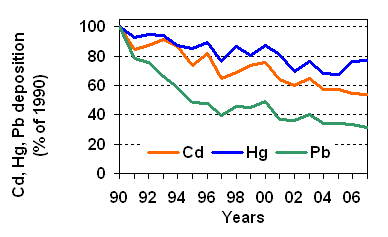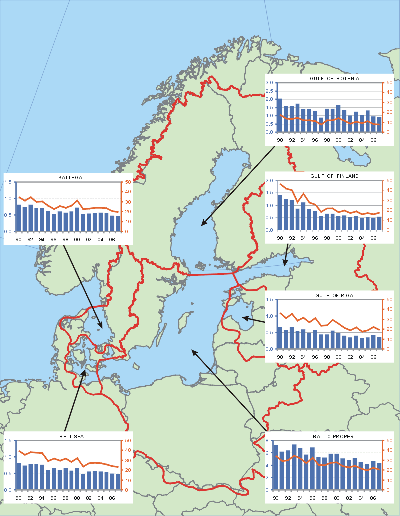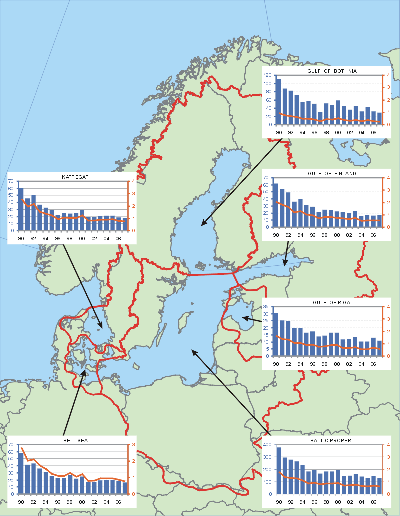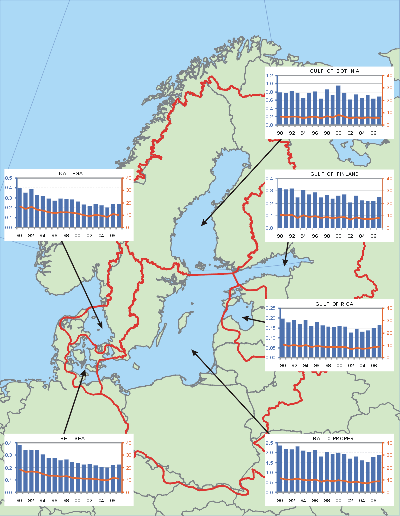Atmospheric deposition of heavy metals on the Baltic Sea
|
||||
Key message
![]() Levels of annual total atmospheric deposition of heavy metals to the Baltic Sea have decreased in period from 1990 to 2007 by 46% for cadmium, 23% for mercury, and 69% for lead.
Levels of annual total atmospheric deposition of heavy metals to the Baltic Sea have decreased in period from 1990 to 2007 by 46% for cadmium, 23% for mercury, and 69% for lead.
Results and Assessment
Relevance of the indicator for describing the developments in the environment
This indicator shows the levels and trends in cadmium, mercury, and lead atmospheric deposition to the Baltic Sea. The deposition of heavy metals represents the pressure of emission sources on the Baltic Sea aquatic environment.
Policy relevance and policy reference
HELCOM adopted a Recommendation in May 2001 for the cessation of hazardous substance discharges/emissions by 2020, with the ultimate aim of achieving concentrations in the environment near to background values for naturally occurring substances and close to zero for man-made synthetic substances.
Assessment
Levels of annual total atmospheric deposition of heavy heavy metalsmetals heavy metals heavy metals to the surface of the Baltic Sea have substantially decreased in period 1990-2007 (Figure 1). The most significant drop in HM deposition over the Baltic Sea is obtained for lead (69%) followed by cadmium (46%), and mercury (23%). The most essential decrease in HM deposition over individual sub-basins of the Baltic Sea can be noted for lead deposition to the Gulf of Bothnia (74%). In case of cadmium deposition the most substantial decrease takes place in the Gulf of Finland (63%). Largest decrease in mercury deposition is obtained for the Belt Sea and the Kattegat (41%). The highest level of HM deposition fluxes over the Baltic Sea is noted for its southern and western parts, in particular, the Belt Sea, the Kattegat, and the Baltic Proper. Among the HELCOM countries the most significant contributions to deposition over the Baltic Sea belong to Poland, Germany, and Russia.
The reduction of atmospheric input of lead, cadmium, and mercury to the Baltic Sea is a result of abatement measures as well as of economic contraction and industrial restructuring in Poland, Estonia, Latvia, Lithuania, and Russia in early 1990s.

Figure 1: Computed total annual atmospheric deposition of cadmium, mercury, and lead to the Baltic Sea for the period 1990-2007, (% of 1990).
Figure 2: Time-series of computed total annual atmospheric deposition of cadmium to six sub-basins of the Baltic Sea for the period 1990-2007 in tonnes/year as bars (left axis) and total deposition fluxes in g/km2/year as lines (right axis). Note that different scales are used for total deposition in tonnes/year and the same scales for total deposition fluxes. Click image to enlarge.
Figure 3: Time-series of computed total annual atmospheric deposition of lead to six sub-basins of the Baltic Sea for the period 1990-2007 in tonnes/year as bars (left axis) and total deposition fluxes in kg/km2/year as lines (right axis). Note that different scales are used for total deposition in tonnes/year and the same scales for total deposition fluxes. Click image to enlarge.
Figure 4: Time-series of computed total annual atmospheric deposition of mercury to six sub-basins of the Baltic Sea for the period 1990-2007 in tonnes/year as bars (left axis) and total deposition fluxes in g/km2/year as lines (right axis). Note that different scales are used for total deposition in tonnes/year and the same scales for total deposition fluxes. Click image to enlarge.
Data
Table 1. Computed annual total deposition of cadmium to six Baltic Sea sub-basins for period 1990-2007. Units: tonnes/year
| 1990 | 1991 | 1992 | 1993 | 1994 | 1995 | 1996 | 1997 | 1998 | 1999 | 2000 | 2001 | 2002 | 2003 | 2004 | 2005 | 2006 | 2007 | |
| GUB | 2.03 | 1.59 | 1.57 | 1.71 | 1.39 | 1.38 | 1.28 | 0.88 | 1.41 | 1.41 | 1.63 | 1.33 | 1.01 | 1.23 | 1.03 | 1.30 | 0.95 | 0.89 |
| BAP | 7.26 | 6.12 | 6.34 | 7.32 | 6.71 | 5.67 | 6.82 | 5.30 | 5.20 | 5.79 | 5.83 | 5.04 | 4.80 | 5.12 | 4.48 | 4.18 | 4.66 | 4.33 |
| GUF | 1.40 | 1.25 | 1.21 | 0.85 | 1.11 | 0.84 | 0.77 | 0.56 | 0.66 | 0.65 | 0.54 | 0.59 | 0.52 | 0.56 | 0.48 | 0.52 | 0.48 | 0.52 |
| GUR | 0.67 | 0.57 | 0.66 | 0.53 | 0.59 | 0.49 | 0.58 | 0.43 | 0.44 | 0.55 | 0.47 | 0.39 | 0.35 | 0.40 | 0.33 | 0.35 | 0.41 | 0.36 |
| BES | 0.81 | 0.72 | 0.78 | 0.77 | 0.76 | 0.59 | 0.65 | 0.61 | 0.65 | 0.57 | 0.66 | 0.48 | 0.55 | 0.56 | 0.55 | 0.53 | 0.49 | 0.47 |
| KAT | 0.81 | 0.73 | 0.81 | 0.70 | 0.71 | 0.61 | 0.53 | 0.60 | 0.56 | 0.61 | 0.72 | 0.53 | 0.53 | 0.55 | 0.56 | 0.55 | 0.48 | 0.46 |
| BAS | 13.0 | 11.0 | 11.4 | 11.9 | 11.3 | 9.6 | 10.6 | 8.4 | 8.9 | 9.6 | 9.9 | 8.4 | 7.8 | 8.4 | 7.4 | 7.4 | 7.5 | 7.0 |
Table 2. Computed annual total deposition of lead to six Baltic Sea sub-basins for period 1990-2007. Units: tonnes/year
| 1990 | 1991 | 1992 | 1993 | 1994 | 1995 | 1996 | 1997 | 1998 | 1999 | 2000 | 2001 | 2002 | 2003 | 2004 | 2005 | 2006 | 2007 | |
| GUB | 110 | 87 | 82 | 71 | 55 | 56 | 50 | 31 | 51 | 47 | 58 | 45 | 36 | 44 | 32 | 42 | 32 | 29 |
| BAP | 377 | 292 | 276 | 264 | 232 | 180 | 194 | 163 | 180 | 181 | 190 | 143 | 148 | 162 | 140 | 128 | 143 | 128 |
| GUF | 62 | 54 | 49 | 36 | 39 | 31 | 28 | 21 | 25 | 24 | 22 | 21 | 20 | 23 | 16 | 16 | 16 | 16 |
| GUR | 31 | 25 | 25 | 20 | 20 | 16 | 17 | 14 | 14 | 16 | 16 | 12 | 12 | 13 | 10 | 10 | 13 | 11 |
| BES | 58 | 42 | 43 | 36 | 31 | 25 | 23 | 23 | 26 | 22 | 25 | 17 | 17 | 19 | 19 | 20 | 18 | 16 |
| KAT | 60 | 46 | 50 | 36 | 32 | 29 | 22 | 25 | 24 | 24 | 28 | 19 | 19 | 21 | 21 | 21 | 19 | 17 |
| BAS | 697 | 545 | 525 | 463 | 409 | 338 | 334 | 277 | 320 | 314 | 340 | 257 | 252 | 283 | 238 | 237 | 240 | 217 |
Table 3. Computed annual total deposition of mercury to six Baltic Sea sub-basins for period 1990-2007. Units: tonnes/year
| 1990 | 1991 | 1992 | 1993 | 1994 | 1995 | 1996 | 1997 | 1998 | 1999 | 2000 | 2001 | 2002 | 2003 | 2004 | 2005 | 2006 | 2007 | |
| GUB | 0.79 | 0.77 | 0.82 | 0.78 | 0.66 | 0.78 | 0.81 | 0.63 | 0.86 | 0.73 | 0.96 | 0.78 | 0.62 | 0.74 | 0.65 | 0.72 | 0.64 | 0.69 |
| BAP | 2.35 | 2.18 | 2.16 | 2.31 | 2.09 | 2.02 | 2.14 | 1.80 | 2.00 | 1.91 | 1.99 | 1.92 | 1.68 | 1.80 | 1.59 | 1.52 | 1.76 | 1.86 |
| GUF | 0.32 | 0.31 | 0.32 | 0.25 | 0.31 | 0.27 | 0.29 | 0.25 | 0.26 | 0.24 | 0.26 | 0.27 | 0.20 | 0.26 | 0.22 | 0.22 | 0.22 | 0.25 |
| GUR | 0.20 | 0.18 | 0.19 | 0.17 | 0.19 | 0.16 | 0.18 | 0.16 | 0.16 | 0.15 | 0.16 | 0.16 | 0.13 | 0.15 | 0.13 | 0.14 | 0.15 | 0.17 |
| BES | 0.38 | 0.34 | 0.34 | 0.34 | 0.30 | 0.27 | 0.27 | 0.26 | 0.26 | 0.24 | 0.23 | 0.22 | 0.22 | 0.21 | 0.20 | 0.20 | 0.22 | 0.22 |
| KAT | 0.40 | 0.35 | 0.39 | 0.33 | 0.32 | 0.29 | 0.27 | 0.29 | 0.29 | 0.28 | 0.26 | 0.23 | 0.22 | 0.24 | 0.22 | 0.20 | 0.24 | 0.24 |
| BAS | 4.4 | 4.1 | 4.2 | 4.2 | 3.9 | 3.8 | 4.0 | 3.4 | 3.8 | 3.6 | 3.9 | 3.6 | 3.1 | 3.4 | 3.0 | 3.0 | 3.2 | 3.4 |
Metadata
Technical information:
1. Source:
EMEP/MSC-E
2. Description of data:
Levels of atmospheric deposition of heavy metals over the Baltic Sea were obtained using the latest version of MSCE-HM model developed at EMEP/MSC-E (Travnikov and Ilyin, 2005). The latest available official emission data for the HELCOM countries have been used in the model computations. Emissions of all three metals for each year of this period were officially reported by most of HELCOM countries. These data are available from the EMEP Centre on Emission Inventories and Projections (CEIP) (http://www.ceip.at/). The Russian Federation did not submit information for 2001, 2006 and 2007. Therefore the values of emissions from Russia for 2001 were obtained using interpolation between emissions for 2000 and 2002 and for 2006 and 2007 the same level of emissions as for 2005 was assumed in model simulations. Finland did not report emission for 1999 which were estimated using interpolation of emissions for 1998 and 2000. These data were used for modelling of transboundary air pollution by heavy metals within European region including the Baltic Sea and its catchment area.
3. Geographical coverage:
Atmospheric deposition of lead, cadmium, and mercury were obtained for the European region and surrounding areas covered by the EMEP modelling domain.
4. Temporal coverage:
Time-series of annual atmospheric deposition are available for the period 1990 – 2007.
5. Methodology and frequency of data collection:
Atmospheric input and source allocation budgets of heavy metals (cadmium, lead, and mercury) to the Baltic Sea and its catchment area were computed using the latest version of MSCE-HM model. MSCE-HM is the regional-scale model operating within the EMEP region. This is a three-dimensional Eulerian model which includes processes of emission, advection, turbulent diffusion, chemical transformations of mercury, wet and dry deposition, and inflow of pollutant into the model domain. Horizontal grid of the model is defined using stereographic projection with spatial resolution 50 km at 60º latitude. The description of EMEP horizontal grid system can be found in the internet (http://www.emep.int/grid/index.html). Vertical structure of the model consists of 15 non-uniform layers defined in the terrain-following s-coordinates and covers almost the whole troposphere. Detailed description of the model can be found in EMEP reports (Travnikov and Ilyin, 2005) and in the Internet on EMEP web page (http://www.emep.int) under the link to information on Heavy Metals. Meteorological data used in the calculations for 1990-2007 were obtained using MM5 meteorological data preprocessor on the basis of the Re-analysis project data prepared by National Centers for Environmental Predictions together with National Center of the Atmospheric Research (NCEP/NCAR) in the USA (http://wesley.ncep.noaa.gov/reanalysis.html) ) and meteorological analysis of European Centre for Medium-Range Weather Forecasts (ECMWF).
Calculations of atmospheric transport and deposition of lead, cadmium, and mercury are provided on the regular basis annually two years in arrears on the basis of emission data officially submitted by Parties to CLRTAP Convention.
Quality information:
6. Strength and weakness:
Strength: annually updated information on atmospheric input of lead, cadmium, and mercury to the Baltic Sea and its sub-basins.
Weakness: uncertainties in officially submitted data on emissions of heavy metals.
7. Uncertainty:
The MSCE-HM model has been verified in a number of intercomparison campaigns with other regional HM transport models (Sofiev et al., 1996; Gusev et al., 2000; Ryaboshapko et al., 2001,2005) and has been qualified by means of sensitivity and uncertainty studies (Travnikov, 2000). It was concluded in these publications that the results of heavy metal airborne transport modelling were in satisfactory agreement with the available measurements and the discrepancies did not exceed on average a factor of two. The comparison of calculated versus measured data indicates that the model predicts the observed air concentrations of lead and cadmium within the accuracy of 30%. For concentrations in precipitation the difference between calculated and measured values may reach two times. Computed mercury concentrations deviate from measured values within a factor of two.
The model was thoroughly reviewed at the workshop held in October, 2005 under supervision of the EMEP Task Force of Measurements and Modelling (TFMM). It was concluded that “MSC-E model is suitable for the evaluation of long-range transboundary transport and deposition of HMs in Europe” [ECE/EB.AIR/GE.1/2006/4].
8. Further work required:
Further work is required on reducing uncertainties in emission data and modelling approaches used in MSCE-HM model.
References
Gusev A., Ilyin I., Petersen G., van Pul A. and Syrakov D. [2000] Long-range transport model intercomparison studies. Model intercomparison study for cadmium. EMEP/ESC-E Report 2/2000, Meteorological Synthesizing Centre – East, Moscow, Russia. (http://www.msceast.org/reps/2_2000.zip)
Ilyin I., O. Rozovskaya, V. Sokovykh, O. Travnikov (2007) Atmospheric modelling of heavy metal pollution in Europe: Further development and evaluation of the MSCE-HM model. EMEP/MSC-E Technical Report 4/2007. (http://www.msceast.org/reps/4_2007.zip)
Ryaboshapko A., Ilyin I., Bullock R., Ebinghaus R., Lohman K., Munthe J., Petersen G., Segneur C., Wangberg I. [2001] Intercomparison study of numerical models for long-range atmospheric transport of mercury. Stage I: Comparison of chemical modules for mercury transformations in a cloud/fog environment. EMEP/MSC-E Technical report 2/2001, Meteorological Synthesizing Centre – East, Moscow, Russia. (http://www.msceast.org/abstract/201.html)
Ryaboshapko A., Artz R., Bullock R., Christensen J., Cohen M., Draxler R., Ilyin I., Munthe J., Pacyna J., Petersen G., Syrakov D., and Travnikov O. [2005] Itercopmparison study of numerical models for long-range atmospheric transport of mercury. Stage III. Comparison of modelling results with long-term observations and comparison of calculated itens of regional balances. EMEP/MSC-E Technical Report 1/2005, Meteorological Synthesizing Centre – East, Moscow, Russia. (http://www.msceast.org/reps/1_2005.zip)
Sofiev M., Maslyaev A. and Gusev A. [1996] Heavy metal model intercomparison. Methodology and results for Pb in 1990. EMEP/MSC-E Report 2/1996, Meteorological Synthesizing Centre - East, Moscow, Russia. (http://www.msceast.org/reps/2_1996.zip)
Travnikov O. [2000] Uncertainty analysis of heavy metals long-range transport modelling. EMEP/MSC-E Technical note 9/2000, Meteorological Synthesizing Centre - East, Moscow, Russia. (http://www.msceast.org/abstract/900.html)
Travnikov O. and Ilyin I. (2005) Regional Model MSCE-HM of Heavy Metal Transboundary Air Pollution in Europe. EMEP/MSC-E Technical Report 6/2005. (http://www.msceast.org/events/review/hm_description.html)
For reference purposes, please cite this indicator fact sheet as follows:
[Author’s name(s)], [Year]. [Indicator Fact Sheet title]. HELCOM Indicator Fact Sheets 2009. Online. [Date Viewed], http://www.helcom.fi/environment2/ifs/en_GB/cover/.
Last updated: 2 November 2009




